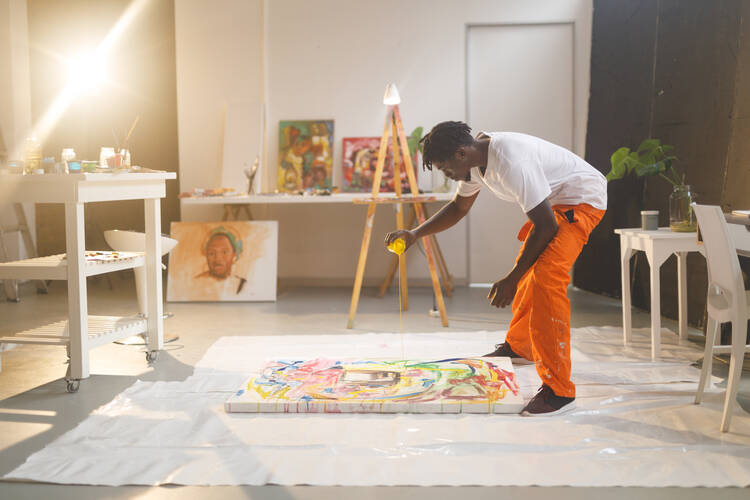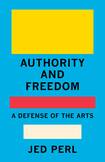Review: Next time you go to an art museum, bring Jed Perl’s latest book. It will be the ideal companion.
It is hard to imagine a better companion on a stroll through an art museum than Jed Perl. Here is a critic with an encyclopedic knowledge of the aesthetic techniques, genres and developmental arcs of art through the ages—to say nothing of his storehouse of anecdotes and examples. But Perl is also a down-to-earth mensch who never lets his vast learning swamp his humanity or the warm common touch of his writing. In his latest book, Authority and Freedom: A Defense of the Arts, Perl takes us on a lively tour through the mental museum of his mind and his many gathered notions on the age-old interplay of forces “that pit the authority of a tradition against the freedom of the individual artist.”
As he did in his two-volume masterwork on the artist Alexander Calder—The Conquest of Time and The Conquest of Space—Perl likes to divide his work into dichotomous categories roomy enough to accommodate his wide reading and ravenous curiosity. The authority-versus-freedom construct has been a staple of aesthetics ever since Apollo, god of order, and Dionysus, god of ecstasy, squared off on Mount Olympus, and it remains an effective paradigm through which to examine any age of art.
Our age, according to Perl, is one in which “the idea of the work of art as an imaginative achievement to which an audience freely responds has been replaced” by the increasingly inexorable “assumption that a work of art should promote a particular idea or ideology.” He argues that the pressure for artists to “perform some clearly defined civic or community service” can reduce a work of art to being a kind of “comrade in arms to some supposedly more stable or socially significant aspect of the world.”
Woe to the career prospects of the artist who does not want to be part of what Joan Didion would call a “dictatorship of good intentions.”
Fortunately, audiences of late have begun to weary of the simplistic “social justice” box-checking and treacly virtue-signaling on offer in this time of what feels like the “kindergartenization” of our culture. But woe to the career prospects of the artist who does not want to be part of what Joan Didion would call a “dictatorship of good intentions.”
Into all this Perl lobs a bracing and much needed corrective in the form of the central battle cry of Authority and Freedom:
I want to release art from the stranglehold of relevance—from the insistence that works of art, whether classical or contemporary, are validated (or invalidated) by the extent to which they line up with (or fail to line up with) our current social and political concerns. I want to convince a public inclined to look first for relevance that art’s relevance has everything to do with what many regard as its irrelevances.
Perl makes a strong case that the itch to be fashionably relevant rarely creates art as powerful as work that emerges from the dynamic tension between an individual artist’s quest for expressive freedom and the innate authority of the “fundamentals” of his or her art form.
“No matter how the world encroaches on the artist,” Perl insists, “the artist in the act of creation must stand firm in the knowledge that art has its own laws and logic.” It is these laws and this logic that he believes form the “authority” that each artist’s will-to-freedom must push against. As he demonstrates in the many apt and entertainingly described examples he presents, this is the crucible from which great art emerges.
Touring us through a gamut of genres, historical epochs, famous personalities and artistic disciplines, Perl is as convincing in his “artist-versus-her-art” postulations as he is eclectic in his choice of evidence. One minute he has the writer Flannery O’Connor vowing that the best art is “wholly concerned with the good of that which is made.” The next minute he is discussing 1972 concert footage of the singer Aretha Franklin to show us the “solitude of an artist at the height of her powers.”
Perl is as convincing in his “artist-versus-her-art” postulations as he is eclectic in his choice of evidence.
Perl’s authority-versus-freedom analysis of Michelangelo’s “licentious use of classical vocabulary” in his design of the vestibule of the Laurentian Library is every bit as illuminating as his many dashed-off gems, including what is, for my money, the best definition I’ve ever heard of jazz: “a dazzlingly authoritative response to the relatively simple authority of a tune or a song.” (John Coltrane’s rendition of the ditty “My Favorite Things” from “The Sound of Music” comes to mind.) All this enjoyable variety is put in the service of Perl’s abiding belief in the lone artist working at her art rather than using art to fashion an ideological message.
In one of his best chapters, “Planning and Making,” Perl uses Paul Taylor’s book Dancemakers to drive home the point that whether the artist is a cutting-edge, modern-dance choreographer like Taylor, or one of the many Renaissance masters about whom Perl shares insights throughout this book, artists are first and foremost makers: toilers who turn out a product, the practical imperatives of which must be folded into every hard day’s work.
Perl quotes from the letters of Giuseppe Verdi to show us how this colossus of composition was, indeed, a “maker,” a worker who simply talked shop. “Please also ask the conductor to keep an eye on the dance rehearsal from time to time to ensure the dances remain at the tempi I have asked for,” Verdi says in language as canny and chatty as any post-rehearsal email dashed off yesterday. Anyone who has had enough direct contact with gifted creators—especially creators in the process of doing their work—can attest to the fact that when the greats of the theater, art, dance or music talk to each other, it is rarely about grandiose concepts or the high twaddle of ideology. They talk about the details, the “tempi,” the nuanced nuts and bolts of technique.
There is a reason the paintings that grace the museum walls Jed Perl knows and loves, and sagely leads us through in Authority and Freedom, are called works of art.
The best and most moving chapter (in a book that is unusually moving for a work of art criticism) is “The Idea of Vocation.” Here Perl returns the word vocation to its spiritual if not altogether religious underpinnings, showing us how holy the “planning and making” of his previous chapter can be in the hands of an artist determined to achieve a new aesthetic freedom from the “authority” of his or her established ways of working. “Even an artist as determinedly secular as Picasso saw echoes of religious vocation in his experience as artist,” Perl writes as he takes us through the creation of a painting that has come to be thought of as one the great works of “social justice” art: Pablo Picasso’s “Guernica.”
Perl reminds us that the initial impetus for this work was a culmination of several smaller studies done over years by Picasso, all centered on “the theme of the artist in his studio,” the very authority-versus-freedom crucible Perl comes back to time and again. Yes, the painting became “almost universally accepted as an indictment of humanity’s inhumanity,” and is without question localized in the April 1937 bombing by the Nazis of the small town for which the painting was named, but Perl contends that “the key to its greatness was precisely Picasso’s rejection of a journalistic or propagandistic approach” to his actualwork on the painting.
Perl’s book is so full of these sorts of avuncular museum-companion insights that it should be required reading for every young person who wants a life in the arts. In a day and age when young people are often averse to trusting in the incremental progress and spiritual development that comes from pushing one’s personal urge for expressive freedom up against the hard authority of the technical limits of an art form, Perl’s work shows that great art is far more likely to emerge from that fission than from the “will-to-relevance” that animates the creative work of so many social-justice careerists who are now enjoying their brief moment in the sun.
“Before everything else the artist must be a rationalist and a pragmatist,” Perl echoes, loud enough to make a docent scowl, “The job must get done!” There is a reason the paintings that grace the museum walls Jed Perl knows and loves, and sagely leads us through in Authority and Freedom, are called works of art.
This article also appeared in print, under the headline “The Artist At Work,” in the September 2022, issue.











